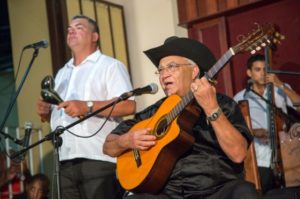
A follow-up to the 1999 film about a group of veteran Cuban musicians put together by Ry Cooder explores the background of the original recording and film, and shows the subsequent lives and careers of the group members.
In 1996, Nick Gold, a British music producer, asked the American guitarist Ry Cooder to come to Havana and help him record a few sessions with some veteran Cuban musicians. Cooder agreed, and in the process discovered a marvelous world, totally new to him—the traditional music of Cuba known as son.
In six days, they recorded an album which they titled “Buena Vista Social Club,” after one of the most popular dance clubs from the old days in Havana. That album became a huge hit, selling more than five million copies, which was a lot for an independent release. It won a bunch of Grammys. Then, two years later, Cooder was doing the music for a film by German director Wim Wenders. Wenders heard the album and decided he wanted to do a film about these musicians. He and Cooder went to Cuba, where Wenders interviewed the band, filmed them at work, and produced a film, also called Buena Vista Social Club, an excellent picture that culminates with the group’s concert at Carnegie Hall. It was released in 1999, and it too was a big success. It introduced some of the great names in Cuban music to a world that had been mostly unaware. And if you haven’t seen it, I highly recommend you do—most of all for the music, a vibrant sound combining soulful vocals with guitars, piano, bass, drums, and a horn section, in moods ranging from tenderly romantic to melancholy to joyful and boisterous.
Now, 18 years later, British director Lucy Walker presents a follow-up to that film called Buena Vista Social Club: Adios. Because of the title, I expected the picture to be about the further career of the group, but Walker is a little bit more ambitious than that. The first two thirds of the movie delves into the back story of the original album and film. We learn about the development of Cuban music over the years and its connection to the struggles of African slaves and later to peasants and their survival of economic hardship. The conga drums were actually outlawed until the 1930s, for fear of political unrest. But they came back, and in the 1940s and 1950s, Cuban music experienced its golden age. Walker has dug up some amazing old footage from that era, including some showing vocalists Ibrahim Ferrer and Omara Portuondo when they were young.
The interviews go deep into the life stories of the musicians, and ultimately it is the gentle and sweet-toned Ferrer who becomes a main focus of the picture. He had given up on music, bitter and impoverished, and was shining shoes for a living when Juan de Marcos Gonzales looked him up and asked him if he wanted to sing again. That started his ascent from obscurity to success, and one of the funny, but also poignant notes of the film is Ferrer wondering out loud why he became famous now, in his 70s, when his voice is shot and he can barely walk. He’s exaggerating about both, and as regards his voice I don’t doubt that it lost something from the golden days, but it was still a fine instrument.
Many of the movie’s most touching moments are centered on similar themes: old musicians who love what they do just for the sake of it, marveling that they are finally being recognized. And we say goodbye to several members of the band who died, including Compay Segundo, singer and guitarist, pianist Ruben Gonzalez (both died in 2003), and Ferrer, who died in 2005. The film shows the group continuing on with the addition of new members, playing at the Obama White House and in Miami.
I have only one small problem with Buena Vista Social Club: Adios, which is that I don’t think we ever hear one song all the way through. We see and hear sections of performances, which Walker must have felt was necessary in order to include everything she could about the band. In the end, it doesn’t matter much, because the constant presence of this music on the soundtrack seeps into your soul and fills you with beauty and gratitude.






